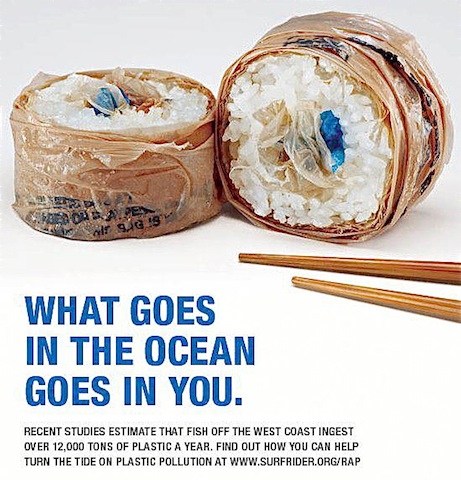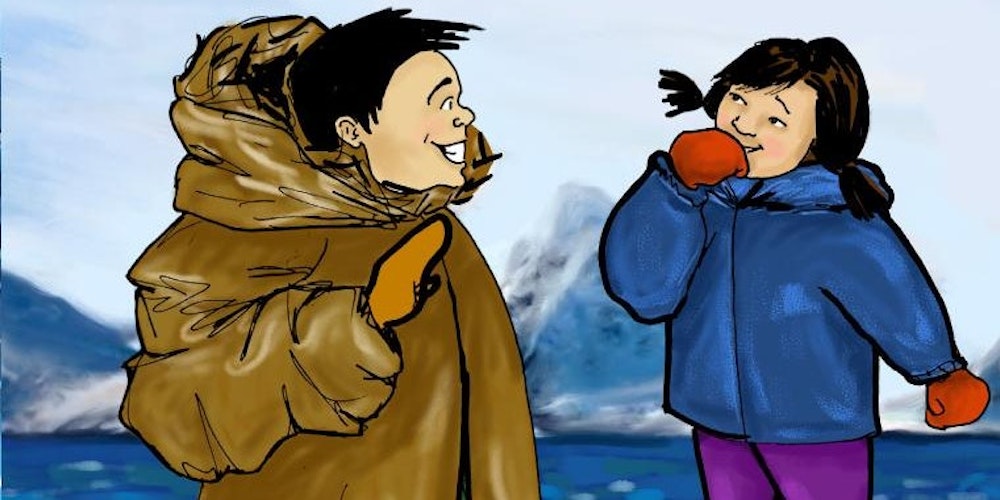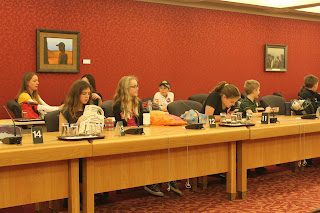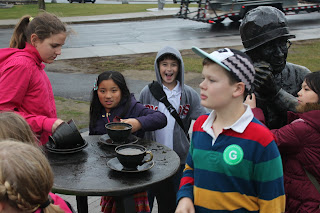I told the class about this story a couple of months ago, and they brought it up today...so I shared it with them at the end of the day. I think it is the perfect story, but perhaps because it is close to home. You can read it and judge for yourself. I think the class appreciated it in many ways. Happy holidays to you and your families.
Christmas Wish Takes Wing
FIRST POSTED: THURSDAY, DECEMBER 24, 2009
06:53 AM EST |
This is a story about a
Christmas present. It is also a story about children, although not in the
normal way, with children being either the supplicants or the beneficiaries of
some seasonal largesse.
In this Christmas story, to
be honest, there is barely room for adults. It is grade-school children who
play the major roles. Who push along the narrative. Who craft the ending.
All the children in the story
attended Churchill Alternative School Ottawa
Many of the children you are
going to meet have wonderful names - Willow Sharpe, Aisha Jansen, Johan
Westeind - and all play major roles, although to be fair and accurate there is
one child at the centre of the story.
She is a nine-year-old girl
named Anna MacDonald. We'll start with her.
- - -
Anna MacDonald was born in
1998 with Down syndrome. The second child of Mary Jansen and Al MacDonald, her
parents had no warning of how their life was about to change. They learned of
their daughter's medical condition in the delivery room.
Down syndrome, although it
seems a strange thing to write, was only the beginning of Anna's troubles. She
was also born with a congenital heart defect. At the age of eight months she
had open-heart surgery.
Then, at the age of four,
she was diagnosed with leukemia.
"It seemed to be one
thing after another," remembers Al MacDonald, who works in the mapping
division of Statistics Canada. "I had to go on a reduced workload, just so
I could be there for Anna. Mary became a stay-at-home mom. It seemed we were
always in the hospital."
The strange thing about
Anna, though, was she never complained. When she lost her hair because of chemotherapy
treatments - no complaints. When she was too ill to eat - no complaints.
In fact, Anna tended to
celebrate even a bad day. She would organize tea parties with her nurses. Or
plan exotic, sea-cruise vacations with other children in the cancer wing of the
Children's Hospital
of Eastern Ontario
In the autumn of 2006, with
her cancer in remission, she was re-enrolled in Churchill Alternative School
No one who was at the school
at the time will ever forget her arrival.
- - -
It will help with the rest
of the story if you can conjure up a mental image of Anna MacDonald. Imagine a
nine-year-old girl with a plump, full face. A constant smile. A voice that was
singing as often as it was talking.
Now imagine confidence, a
child without an ounce of self-doubt and definite views on how a day should
proceed. All right, you may be getting there.
"I have seen Anna march
onto a soccer (pitch) and get players to stop and help her with a play,"
says Lyne Filion, a special-education instructor at Churchill school.
"She would stop the
game, and then she would tell the boys: 'I need you to be the squirrel. And I
need you to be the prince.' What's more, the boys would do it."
The boys needed to help out
at costume parties as well. And you better high-five her whenever you saw her
in the hallway. No excuses, or she'd track you down.
The children at the school,
even the youngest, were aware that Anna had Down syndrome and battled cancer in
the past. Yet if there was anything patronizing about the way they treated her,
no teacher ever saw it.
"She was Duncan
MacDonald's little sister, and great fun to be around," is how Ray
Kalynuk, a grade 5-6 teacher at Churchill, describes the children's attitude.
Anyway, she was a hard child
to ignore, let's put it that way, and maybe that's why the next year, when
school started again, she was missed right away.
The children heard that
Anna's cancer had come back. That Duncan
They were still thinking of
her, it turns out, when they attended a Remembrance Day Ceremony that autumn.
And it was while learning about the horrors of war that the children first
heard the story of the thousand cranes.
- - -
Sadako Sasaki was two years
old, and living a mile from ground zero, when the atomic bomb was dropped on Hiroshima Japan
Sasaki spent the last nine
months of her life in hospital and during that time she heard a fable about a
thousand cranes, a popular Asian myth that says a wish will be granted to any
person who makes 1,000 paper cranes.
Inspired by the story,
Sasaki started making majestic, multi-coloured birds in her hospital bed. She
had completed 644 of the birds before dying on Oct. 25, 1955 . There is now a statue to her in Hiroshima
The children at Churchill Alternative School
"I remember thinking
that Sadako had the same disease as Anna," says Terrion. "Then I
started thinking, 'Maybe we should make 1,000 cranes for Anna."
Within five minutes every
child in the class had started folding paper.
- - -
The children take over the
story at this point. Just take it over.
Within days, every classroom
at Churchill Alternative School
"I remember doing
nothing but folding paper that Christmas," says Willow Sharpe. "Once
we started, we couldn't stop."
The teachers at Churchill
watched the frenzied arts and crafts activity with amazement, but also some
concern.
"A lot of boys were
involved in this," remembers Kalynuk. "I kept waiting for them to
lose interest. I mean, these were hockey-playing, rough-and-tumble boys we're
talking about, and yet here they were folding coloured paper any chance they
got."
It's not quick work, by the
way, making 1,000 paper cranes. Before long the children had conscripted
siblings and parents in the task. After that, anyone who had a few spare
minutes and was lurking in the vicinity. They did, after all, have a goal in
mind.
And sure enough, they pulled
it off. They made 1,000 paper cranes. To give to Anna MacDonald as a present.
So one wish could be granted her.
The present was given to her
six days before Christmas.
- - -
The story goes in different
directions here. After making 1,000 paper cranes, then fashioning them into two
mobiles - one for Anna to take home, one to hang in the foyer at Churchill Alternative School
They gave her the present
during a special ceremony at the school, then went home for Christmas. Anna did
the same.
In the new year, when the
children returned, they thought little of Anna's absence. It was now a regular part
of their school routine, and only occasionally did they remember the impromptu
plays and the hallway high fives.
Yet they were shocked to
learn, on Feb. 24, 2008 , that Anna MacDonald had passed away. She had
battled three bouts of cancer. Survived open-heart surgery. But in the end it
was a stroke, a complication from the medical treatment she was receiving, that
killed her.
Children who had spent an
entire Christmas season folding pieces of paper and hoping that wishes do come
true were devastated. Willow Sharpe remembers being "sadder than I thought
possible." Richard Terrion remembers thinking "nothing should be that
unfair."
The young girl's funeral was
better attended than that of a celebrity politician. Hundreds assembled at the
Unitarian church in Westboro to remember a remarkable life. Her dance troupe
performed a number choreographed especially for her. Children from Churchill
sang her favourite songs.
She is buried now in a small
cemetery at Pinhey's Point, one of the most beautiful and rugged spots in the
region, a place where the Ottawa
River rumbles beneath steep
hills that once attracted an English lord who made a doomed attempt to build a
grand empire.
Anna MacDonald was nine
years of age.
- - -
So what to make of it? The
question seems to hang in the air, as I sit in a living room with Al MacDonald,
talking about a thousand paper cranes that were once given to his daughter as a
present.
Did anyone feel
disappointed? Did anyone think a wish had not been granted? I can't help but
wonder about it, as I sit through a painful interview with a man still
struggling to understand life and why his daughter is no longer part of it.
His son still has trouble
dealing with his sister's death, he tells me at one point. His wife is too
distraught to be here. He's keeping things together as best he can. It's day by
day.
But he did want to talk
about the 1,000 cranes. He tells me this without any prompting. I haven't yet
asked a question about the present.
"My wife has thought
about this a lot," says MacDonald. "And we do want the children to
know what they did for us for that Christmas."
"Yes," I say,
"It was a wonderful present."
"No," says
MacDonald, "I don't mean that ... You know, it's a funny thing, and you
can never be completely sure about any of these things, but Anna had a doctor's
appointment the day after the cranes were given to her."
He pauses a minute. Looks
around his living room. There is a Christmas tree framed against a front
window. In the opposite corner is the mobile given to Anna to bring home. The
birds are flying over my head.
In remission
"Funny thing was, her
cancer was in remission during that appointment," MacDonald continues.
"As sick as she was, she was in great health that Christmas. It was
probably the best Christmas she ever had.
"That's a strange
thing, don't you think?"
We spend the next hour
looking at photos taken of Anna that Christmas. A young girl ripping apart
wrapping paper. Posing with her cousin. Not a care in the world, or so it would
appear. So maybe, just maybe, a wish did come true. In Ottawa
Granted by a great many
children. And 1,000 paper cranes.















































































